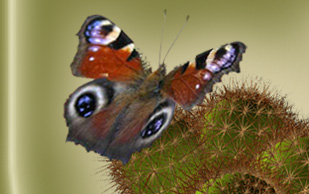Diary of the traveller
Eugeny Safronov
The Southwest USA
Part 2
Next day we moved to another park, Anza-Borrego Desert State Park (Point Е ).
** National Park, second largest in USA (2400 km2), located in Southern California . It was named in honor of Juan Bautista de Anza , well known Spanish explorer .**
The sun shone brightly, the road layed in smooth plane and only hills were seen in the distance.
Various animals came into sight by the road: horses …and suddenly… tigers! Not common, but saber-toothed! On the other side there were the giraffes, and…O, Jesus! Dinosaurs!
The animals were made life-size from metal. There were plenty of them everywhere. It seemed that back-yard Ceretelli had splashed out his idea, how that valley should look like. That scenary repeated many times for a couple of kilometers.
Except «iron horses and tigers» there were fairly live posh ferocactuses with great number of fruits. Unfortunately, more then 80% of seeds were not mellow.
FEROCACTUS acantoides
RUS 264
We had a long way ahead of us to our point «F», approximately 330 miles . Our way was parallel to Mexican border. Here we said good by to California and were welcomed by Arizona desert. In Gila Bend we turned right and reached the town Sanoita near the border. From the USA side it is Organ Pipe Cactus National Monument .
Saguaro cacti (it's the native name of “Candle holders” of the desert)
CARNEGIA gigantea RUS 266.
In the morning we moved further, slowly, with some stops.
CARNEGIA gigantea RUS 267
FEROCACTUS wislizenii RUS 267
MARCHALOCEREUS thurber RUS 267 - the distinctive plant of Sonora desert. Tree-like or bush-like cacti with short steam and with great number of erected shoots, that's why it was named “ Organ pipe”.
MAMMILLARIA tetrancistra RUS 267
AGAVE deserti
RUS 267
Next stop. And there is a tousle of Carnegia gigantea again. Many plants were flowering, also we saw some crested ones.
CYLINDROPUNTHIA versicolor RUS 268
We returned to Gila Bend and took course to the East by one way – road №85. There were many huge Ferocactuses with red-ripe seeds along the road.
FEROCACTUS wislizenii RUS 269
We stayed overnight in Benson camping. The territory was planted with cacti, well watered they looked very nice, many flowered.
There were Echinomastus waiting us ahead.
We saw skie cab-rail by the road and it looked strange in summer. But there is much snow in winter here and skiers use these hills with pleaser. Usually the frost is near -10C , but last winter was record - -28C ! How can cacti survive here?
We reached the next stop point. It's survival indeed! We where surprised very much when we found many plants, but in poor condition, often dried out.
ECHINOMASTUS erectocentrus RUS 271
We found FEROCACTUS wislizenii there. It spends winter in that place. It was like a medium-sised melon and that helped it to resist the frost. There were many mellow fruits on it and we gathered many seeds!
FEROCACTUS wislizenii
We found ECHINOCEREUS fendleri and CORYPHANTHA vivipara not so far also.
ECHINOCEREUS fendleri RUS 272
CORYPHANTHA vivipara RUS 272
However, that time we were forced to pay all attention to a snake… The excellent sample of (Pituophis catenifer)… Photo-session! Adrenalin shot up. The snake fealt the same, I think.
Some nice views.
We left Arizona .
Overnight stop in Lordsberg, New-Mexico. Point G .
I was in high spirits in the morning because I knew: my lovely Horizontalonus were close! It happened so the first point brought us many excellent plants and seeds.
ECHINOCACTUS horizonthalonius RUS 274
GLANDULICACTUS uncinatus RUS 274
ECHINOCEREUS chloranthus RUS 274
I decided to put down the actual temperature in my diary just at that point. 9 AM, + 33C ! But never mind! Everybody was gathering seeds! 2 hours at one point is unusual. Then we went on.
But not far, approximately 3 miles . The terrain began to change, we reached foothills. There were many seeds of Echinocereus. The plants were beautiful.
ECHINOCEREUS dasyacanthus RUS 275
Echinocactus horizontalonus were there too, but fewer. They prefer to grow on planes, not in hills. It's very difficult to gather last year seeds of horizontalonus. And fresh would appear only at autumn.
ECHINOCACTUS horizonthalonius RUS 275
It's handy when seeds lie in a pile. Usually you must take one single-piece by pincer and put it into the pack. But here it was very easy. More often you must seek 1-2-3 seeds at the woolen head of the cacti. More rarely you can find a seed bag… But as a rule the seeds are spread all over the plant, try to hide among the spines, disappear in earth cracks… And all that with + 30 C !
OPUNTIA santa-rita RUS 275
LEPIDOCORYPHANTHA macromeris
Next way 90 miles through El Paso to South-East. On the left is the USA , on the right – Mexico .
Air conditioner made air cool in the car. But we had + 40C outside. Smoke, flames! There were bushes and grass, burning along the road. Looks like Motherland…
We reached the point 276. We had no desire to leave the car, but… it was necessary. Search gave us only some dead plants. They didn't survive the frost in winter. But we found several long-spined cacti alive. Population would rise!
We reached Sierra Blanca, point 277. We rounded it and made a stop. There was a great mount of formidable E.dasiacantus.
ECHINOCEREUS dasyacanthus RUS 277
ECHINOCACTUS horizonthalonius RUS 277
ECHINOCEREUS stramineus RUS 277
GLANDULICACTUS uncinatus RUS 277
We still had 175 miles to South-East before Big Band. One more echinomastus… The sad view… And some not so well escobaries.
The closer we were coming to the point, the more often we made stops. Probably moved faster than planned and now we had a lot of spare time… Only 40 miles to go.
Point 281. We saw new nice Ech.cer. chisoensis. Oh! The temperature is + 41C ! 15 PM.
ECHINOCEREUS chisoensis RUS 281
November 2011г.
To be continued... |

